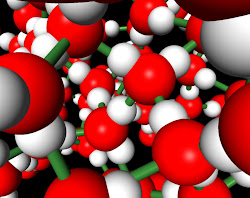
Astrocytes are rising stars
By Tina Hesman Saey
- [From Science News]
Often-ignored brain cells regulate blood flow and make fMRI possible
access
STAR PLAYERSAstrocytes (blue) and neurons (green) in the visual cortex of a ferret. The cells contain dyes that allow researchers to track calcium levels. When neurons are active, astrocytes respond with increased calcium, which leads nearby capillaries to increase blood flow. This is a previously undiscovered role for astrocytes, once thought to only act as support cells for neurons. James Schummers and Hongbo Yu, Laboratory of Mriganka Sur, MIT.
Star-shaped brain cells called astrocytes are finally getting their chance to shine.
Two groups of researchers — one at MIT, the other at Harvard — have shown that astrocytes get the blood pumping to parts of the brain that are thinking hard. These cells may use blood flow and other tricks to rev up communication between neurons or slow it down, and may even play a role in storing information. The findings indicate that astrocytes are not just supporting actors for neurons; they deserve recognition as true costars.
“Astrocytes are typically forgotten,” says Venkatesh Murthy, leader of the Harvard group, but they “are right in the thick of things.”
Neurons have typically gotten the most attention from researchers because they are the brain cells that do all the thinking. But neurons cohabit the brain with a class of cells called glia, which means “glue” in Greek. Glia outnumber neurons in the human brain by a factor of 10 to one, and astrocytes are the most abundant type of glial cell.
The view of astrocytes has changed slowly over the past decade. Astrocytes were once thought to do little more than hold the brain together and they were largely ignored. In recent years, though, scientists have learned that the star-shaped cells have a hand in guiding connections between neurons and controlling levels of chemical messengers in the brain. But those activities were viewed mainly as supporting roles. Now their central function in controlling blood flow indicates that astrocytes deserve higher billing. Without astrocytes, in fact, one of the most powerful tools of neuroscience — functional MRI — would not be possible.
Functional MRIs rely on the premise that blood flow is coordinated with neuron activity, but the mechanism that links blood flow to activity has been a mystery.
Some scientists suspected that astrocytes may play a role in blood flow because the cells have “end feet” that nestle up against synapses — the places where neurons connect — and other end feet that wrap around capillaries. But no one had proven that astrocytes could actually influence blood flow in living animals.
Working with ferrets, Mriganka Sur and colleagues at MIT used an advanced microscopy technique to measure the response of astrocytes to visual stimuli. The group reported its findings June 20 in Science. Neurons in the visual cortex of ferrets, cats, monkeys, humans and other higher mammals are arranged in columns of cells that respond to objects oriented in the same direction. For instance, one column would respond to the vertical edges of a building, while another close-by column would be stimulated by horizontal lines. Columns tuned to every possible orientation of a line are situated close to each other in what neuroscientists call pinwheel centers.
Sur’s postdoctoral researchers James Schummers and Hongbo Yu used fluorescent dyes to show when neurons and astrocytes become active. Neurons respond in split seconds to visual cues flashed into the eyes of anesthetized animals. About three to four seconds after neurons begin firing, calcium levels in the astrocytes begin to rise, a cue that the cell is active and sending signals. Blood flow through capillaries increases following the rise in calcium.
Murthy and his colleagues got similar results with neurons and astrocytes in the odor-sensing centers in the olfactory bulbs of mice. That study appeared June 26 in Neuron.
An astrocyte listens in to the chemical conversation between neurons, soaking up neurotransmitters such as glutamate, the researchers showed. Astrocytes actually use two pathways to respond to glutamate: The cells have receptors for glutamate on the end that nestles next to the synapse, and the cells can also take up the neurotransmitter in another way, the researchers found.
The glia are not just passively eavesdropping. They also regulate levels of neurotransmitters in the synapse, send signals to capillaries to increase blood flow to oxygen-hungry neurons and participate in gathering information, says Frank Kirchhoff, a neuroscientist at the Max Planck Institute of Experimental Medicine in Göttingen, Germany. The two studies demonstrate that astrocytes are involved in signaling in the brain, he says.
Astrocytes not only listen in on neuronal conversations and report to the blood vessels, they also talk back to the neurons, the research demonstrates. Blocking the ability of the astrocyte to respond to glutamate caused neurons to get even more excited.
“That is direct evidence that an astrocyte is not just a pretty face sitting around soaking up [neurotransmitters], but that it also plays a role in computation,” Sur says.
Each astrocyte seems to be intimately associated with a single neuron or a small number of neurons, Sur says. That was a surprise because previous research on slices of brain suggested that astrocytes work together in vast networks. Sur doesn’t rule out the possibility that astrocytes coordinate with each other, but he speculates that they usually act locally — chatting with nearby neuron partners and blood cells within a 10- to 20-micrometer area. Performing similar experiments in wakeful animals might help answer the question, Kirchhoff suggests, because anesthetics may dampen the glial cells’ responses.
Astrocytes are pickier about responding to visual signals than neurons are, the MIT group found. The cells seem to have higher standards than neurons for the amount of stimulus they consider exciting. The researchers don’t yet know whether astrocytes slow blood flow to calm over-excited neurons, or if increasing the blood supply allows neurons to work harder. And the code of calcium signaling within the astrocytes also needs to be worked out, Kirchhoff says.
Some diseases may be caused or complicated by defects in astrocyte function, Murthy says. His team is exploring whether the astrocytes’ ability to control blood flow breaks down with age. The new discoveries will probably force researchers to rethink brain networks to include astrocytes, Sur adds.
“It’s not often that a whole new function for a class of cells is revealed,” Sur says. “It’s like when we first began to understand synaptic transmission 50 years ago. The whole field is open.”
Subscribe to:
Post Comments (Atom)









0 comments:
Post a Comment